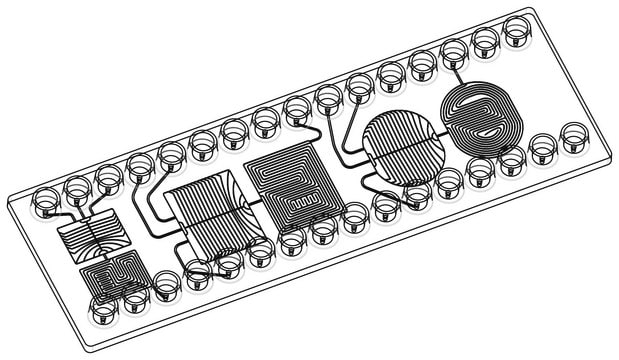926353
Diffusion mixer chip
Fluidic 186, COP
Synonym(s):
Microfluidic chip
Sign Into View Organizational & Contract Pricing
All Photos(5)
About This Item
UNSPSC Code:
42142600
NACRES:
NA.23
Recommended Products
description
Microfludic chip x1
Looking for similar products? Visit Product Comparison Guide
Application
The Diffusion Mixer Fluidic 186 COP microfluidic chip applies passive mixing principles and elongated channels to enforce mixing. Though flows in microchannels are normally laminar, this mixer improves diffusion through a long co-flow of liquids in an elongated meandering channel.
Features and Benefits
- Two identical micromixing units per chip
- Each unit feature four inlets and one outlet
- The micromixing units can be daisy chained to further improve mixing
Components
Chip Properties:
- Luer Interface
- Material: Cyclic Olefin Polymer (COP)
- Channel Depth: 100 μm
- Channel Width Inlets: 100/200 μm
- Channel Width Mixer: 200 μm
- Channel Width Outlet: 200 μm
- Volume Mixing Channel: 4.11 μL
- Length of mixing channel: 217 mm
Certificates of Analysis (COA)
Search for Certificates of Analysis (COA) by entering the products Lot/Batch Number. Lot and Batch Numbers can be found on a product’s label following the words ‘Lot’ or ‘Batch’.
Already Own This Product?
Find documentation for the products that you have recently purchased in the Document Library.
Dongfei Liu et al.
Lab on a chip, 17(11), 1856-1883 (2017-05-10)
The microfluidic technique has brought unique opportunities toward the full control over the production processes for drug delivery carriers, owing to the miniaturisation of the fluidic environment. In comparison to the conventional batch methods, the microfluidic setup provides a range
Sharma T Sanjay et al.
Advanced drug delivery reviews, 128, 3-28 (2017-09-19)
Conventional systematically-administered drugs distribute evenly throughout the body, get degraded and excreted rapidly while crossing many biological barriers, leaving minimum amounts of the drugs at pathological sites. Controlled drug delivery aims to deliver drugs to the target sites at desired
Articles
Microfluidic assembly improves polyamine nanoencapsulation of nucleic acids, overcoming challenges like polydispersity and poor reproducibility.
Our team of scientists has experience in all areas of research including Life Science, Material Science, Chemical Synthesis, Chromatography, Analytical and many others.
Contact Technical Service




